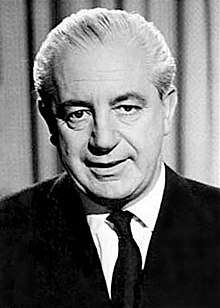Australian federal election, 1966
|
| |||||||||||||||||||||||||||||||
| |||||||||||||||||||||||||||||||
All 124 seats of the Australian House of Representatives 63 seats were needed for a majority | |||||||||||||||||||||||||||||||
|---|---|---|---|---|---|---|---|---|---|---|---|---|---|---|---|---|---|---|---|---|---|---|---|---|---|---|---|---|---|---|---|
| |||||||||||||||||||||||||||||||
| |||||||||||||||||||||||||||||||
Federal elections were held in Australia on 26 November 1966. All 124 seats in the House of Representatives were up for election. The incumbent Liberal–Country coalition government, led by Prime Minister Harold Holt, won an increased majority over the opposition Labor Party, led by Arthur Calwell.
This was the first federal election that future opposition leader Andrew Peacock contested as a member of parliament, having entered parliament at the 1966 Kooyong by-election.
Issues
The new Prime Minister, Harold Holt, was stylish, debonair and popular with the electorate. He cast a sharp contrast with the much rougher figure of Arthur Calwell, who had already lost two elections. Calwell held to the beliefs that had been central to the last Labor Government of 1941–1949, many of which were seen as being old-fashioned in 1966. For example, he was a defender of the White Australia Policy, nationalization. He also came across poorly on television compared to Holt, and looked and sounded older than his 70 years.
In addition, a strong economy and initial enthusiasm for Australia's involvement in the Vietnam War virtually guaranteed the Coalition the election who campaigned with the slogan "Keep Australia secure and prosperous – play it safe".[1] Calwell retired a month after the election and was succeeded by Deputy Labor leader Gough Whitlam.
The election was a landslide win for the Coalition, which won twice as many seats as Labor. Holt's victory was greater than any of Menzies', and it was seen as the electoral high point of both his Prime Ministership and the 23 years of continuous Coalition rule.
Results
| Party | Votes | % | Swing | Seats | Change | ||
|---|---|---|---|---|---|---|---|
| Liberal–Country coalition | 2,520,321 | 49.98 | +3.94 | 82 | +10 | ||
| Liberal | 2,291,964 | 40.14 | +3.05 | 61 | +9 | ||
| Country | 561,926 | 9.84 | +0.90 | 21 | +1 | ||
| Labor | 2,282,834 | 39.98 | –5.49 | 41 | –9 | ||
| Democratic Labor | 417,411 | 7.31 | –0.13 | 0 | 0 | ||
| Liberal Reform | 49,610 | 0.87 | +0.87 | 0 | 0 | ||
| Communist | 23,056 | 0.40 | –0.19 | 0 | 0 | ||
| Independents | 82,948 | 1.45 | +0.98 | 1 | +1 | ||
| Total | 5,709,749 | 124 | +2 | ||||
| Two-party-preferred (estimated) | |||||||
| Liberal–Country coalition | WIN | 56.90 | +4.30 | 82 | +10 | ||
| Labor | 43.10 | −4.30 | 41 | −9 | |||
Independents: Sam Benson
Seats changing hands
| Seat | Pre-1966 | Swing | Post-1966 | ||||||
|---|---|---|---|---|---|---|---|---|---|
| Party | Member | Margin | Margin | Member | Party | ||||
| Adelaide, SA | Labor | Joe Sexton | 7.2 | 10.0 | 2.8 | Andrew Jones | Liberal | ||
| Barton, NSW | Labor | Len Reynolds | 0.7 | 2.9 | 2.2 | Bill Arthur | Liberal | ||
| Batman, Vic | Labor | Sam Benson | N/A | 8.7 | 7.8 | Sam Benson | Independent | ||
| Eden-Monaro, NSW | Labor | Allan Fraser | 2.7 | 3.4 | 0.7 | Dugald Munro | Liberal | ||
| Grey, SA | Labor | Jack Mortimer | 4.8 | 7.8 | 3.0 | Don Jessop | Liberal | ||
| Griffith, Qld | Labor | Wilfred Coutts | 5.8 | 6.9 | 1.1 | Don Cameron | Liberal | ||
| Herbert, Qld | Labor | Ted Harding | 3.2 | 4.3 | 1.1 | Robert Bonnett | Liberal | ||
| Hughes, NSW | Labor | Les Johnson | 2.7 | 4.7 | 2.0 | Don Dobie | Liberal | ||
| Kennedy, Qld | Labor | Bill Riordan | 13.5 | 15.0 | 1.5 | Bob Katter | Country | ||
| Kingston, SA | Labor | Patrick Galvin | 4.5 | 12.7 | 8.2 | Kay Brownbill | Liberal | ||
| Lalor, Vic | Labor | Reg Pollard | 7.0 | 7.7 | 0.7 | Mervyn Lee | Liberal | ||
| Northern Territory, NT | Labor | Jock Nelson | 100.0 | 51.7 | 1.7 | Sam Calder | Country | ||
- Members in italics did not contest their seat at this election.
See also
Notes
References
- University of WA election results in Australia since 1890
- AEC 2PP vote
- Prior to 1984 the AEC did not undertake a full distribution of preferences for statistical purposes. The stored ballot papers for the 1983 election were put through this process prior to their destruction. Therefore, the figures from 1983 onwards show the actual result based on full distribution of preferences.

